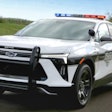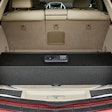Available in a wide range of sizes, prisoner transport vehicles can carry anywhere from one to more than 60 passengers. With the variety of options out there, it can be difficult to know which one to choose. But with the many advancements made in recent years, you'll be sure that safe and efficient models are always available to meet your needs.
Officer Safety
In any situation, officer safety is of utmost importance. Manufacturers and aftermarket companies work hard to install elements that keep prisoners separate from officers whenever possible. A strongly reinforced divider separates the officer compartment from the prisoner area in all prison transport vehicles.
In addition to separation from inmates within, bulletproof glass in the front of some vehicles protects officers from any attack from outside.
Mattman Specialty Vehicles' prisoner transport buses feature a guard station at the head of the vehicle just behind the door, with a desk and a gun locker. This position allows an officer to keep an eye on all inmates as they enter the bus. When the prisoners have been secured, the officer is safely separated from the rest of the bus, as are other officers in the front section. All officer seats have safety belts.
Motor Coach Industries (MCI) buses also offer a rear guard position as an option. An officer stationed there can communicate with other officers on the bus via a hardline intercom that cannot be heard by inmates.
Prisoner Containment
As much for the prisoners' safety as for the safety of the officers, inmates can be separated by powder-coated steel or aluminum dividers. These separation cells help segregate prisoners for safety, security, and convenience.
The general population of inmates usually sits in the back of the bus. A couple of rows of seats can be separated to accommodate female inmates or prisoners of a different security group. At the very front of the prisoner seating area, a one-person section can be installed to hold an especially difficult inmate. When Mattman Specialty Vehicles installs this type of cell on its buses, it is constructed with a solid lower half and a graded upper portion so officers can more easily monitor the person inside while keeping him or her securely restrained. A Lexan covering protects officers from spitting.
For security reasons, all walls are reinforced with steel and windows are made of shatterproof glass and contain various safety features to prevent escape.
"We basically reinforce the interior to make it prisoner-proof," says Bruce Barnes of Mattman Specialty Vehicles.
Most prisoner transport vehicles don't require any form of attached restraints. Handcuffs and leg irons in conjunction with separation cells are usually enough to keep inmates secure. Also, separate restraints for each inmate make moving into and out of the vehicle easier for both inmates and officers. MCI builds its buses with low-to-the-ground steps so prisoners can easily board the bus on their own while wearing leg irons.
While smaller, vans are no less safety-oriented. Vans provide separation between officers and inmates and often have only a small window or none at all in the prisoner area. This limits escape possibilities. A van that holds 15 prisoners can accommodate a separation cell for each row. The number of separators depends on the needs of an agency and on the size of the vehicle, from car, to truck, to van, to bus.
Vehicle Variety
You can often purchase a ready-made prisoner transport vehicle from a bus or van manufacturer. However, sometimes agencies must go to an aftermarket company for custom work that the factory cannot do. You might also choose to convert a traditional vehicle into one capable of prisoner transport. You can arrange this before or after you purchase the vehicle from the manufacturer or a dealer.
Whichever route you take, weigh the options and make a decision based on the number of inmates you plan on carrying and the length of trips you plan to use them for.
Vans usually fit the bill for city departments that might need to transport several passengers for a short distance. Sheriff's departments also use them for taking small numbers of inmates to jail or court. Vans are also used by corrections centers to transport parolees to their jobs. However, these vehicles are not recommended for long journeys.
Buses and custom prisoner transport vehicles can accommodate a large number of inmates. Companies such as MCI and Supreme create vehicles from the ground up, with heavy-duty steel and reinforcements, as well as safety measures not found on traditional vehicles.
Companies such as Mattman either fully upfit traditional buses or vans or add special requirements that couldn't be met by a manufacturer.
Converted trucks, such as those made by UPV, enclose the truck bed and use it as a seating area, which allows for more versatility. The company's converted trucks can serve more than one function. UPV even offers patrol vehicles with separate compartments for a K-9 and a prisoner.
UPV also sells trucks that accommodate four or seven prisoners. The higher capacity is made possible by creating a divider in an extended cab truck. A selection of seats and seating arrangements are available for all floorplans.
Remember to take care, no matter what vehicle you are using to transport prisoners. Stay on guard and use all the resources available to keep you and others safe.
Prisoner Transport Vehicles
Braun Northwest
www.braunnorthwest.com
EME
www.emeusa.com
Fox Equipment
www.fox-intl.com
Havis Shields Equipment
www.havis.com
Mattman Specialty Vehicles
www.mattmanvehicles.com
MCI
www.mcimotorcoach.com
Northeast Kustom Kreations
www.nekk.com
OBS
www.obsinc.net
Odyssey Automotive Specialty
www.odysseyauto.com
Supreme
www.supremeind.com
UPV Police Vehicles
Wilson County Motor
www.policevehicle.com

















